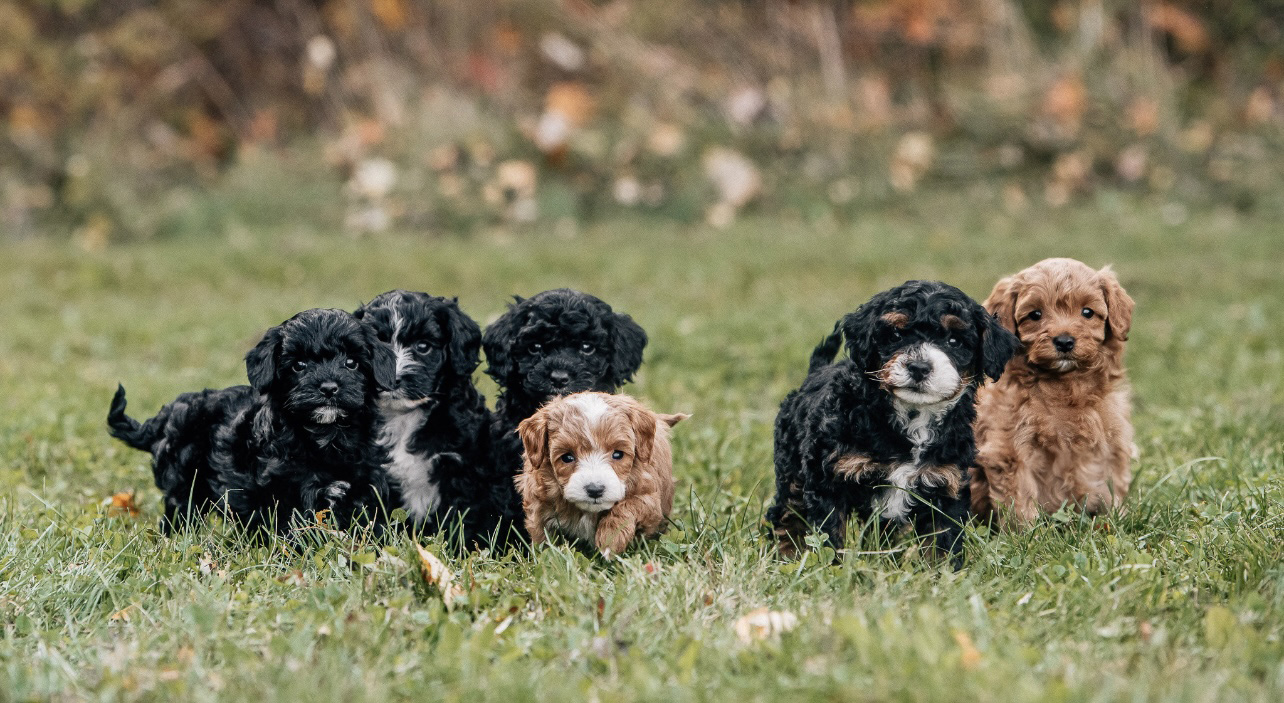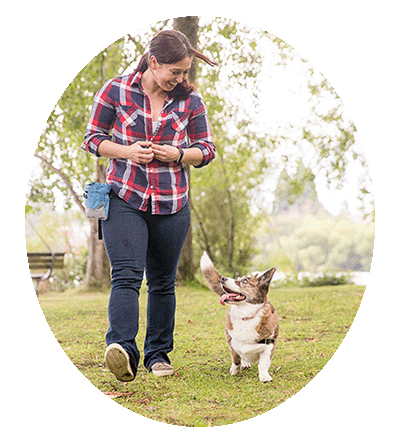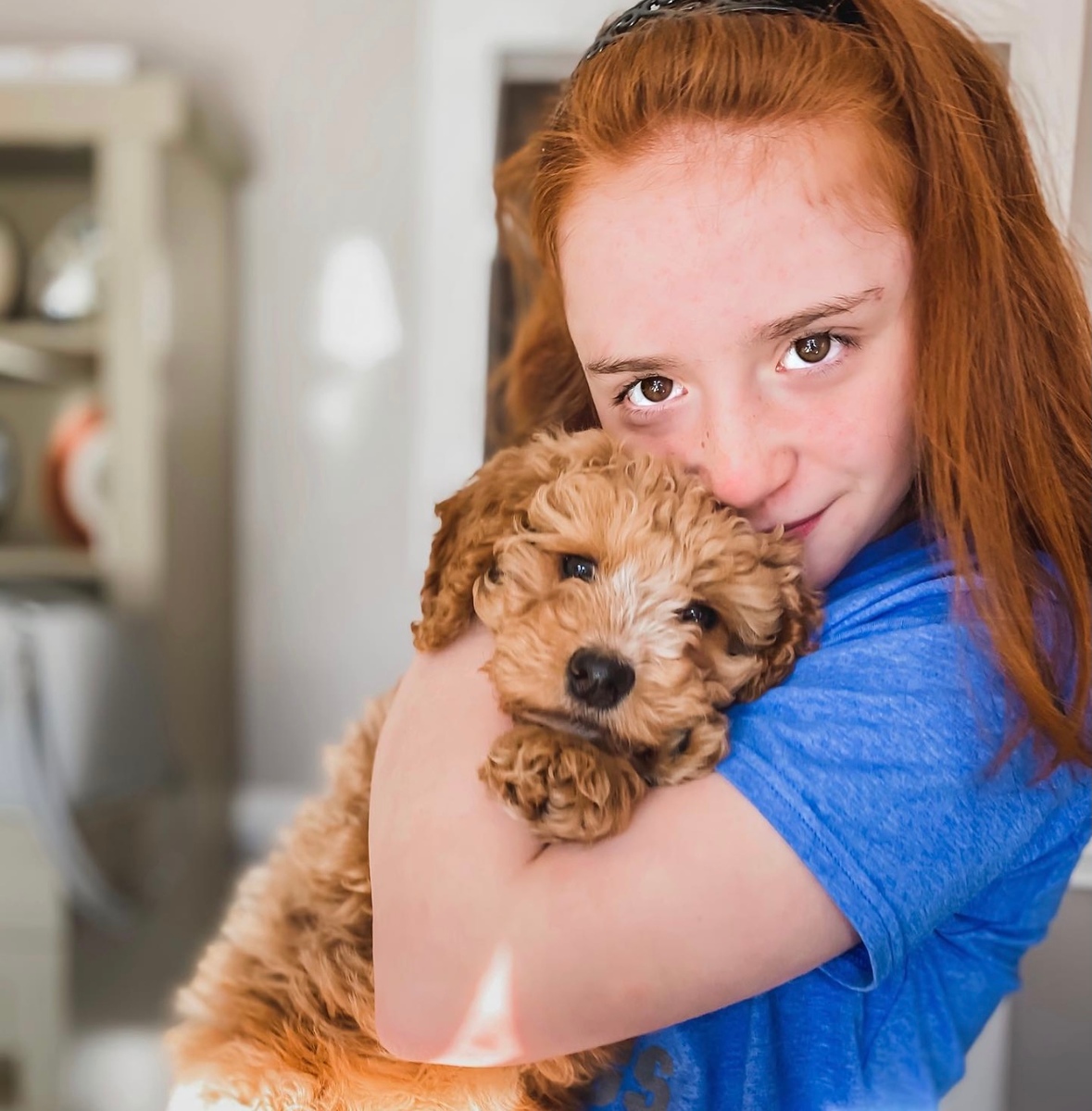Table of Contents
- Take a Deep Breath—This is Temporary
- Why Do Puppies Bite Everything?
- The Good News About Those Needle Teeth
- Understanding Bite Inhibition: Intensity Before Frequency
- The Critical Timeline
- Bad Advice to Ignore: What NOT to Do
- The Right Way: “The Secret” Technique
- Watch and Learn
- You’re Going to Make It
- Frequently Asked Questions
If puppy biting has you feeling exhausted and frustrated, take comfort in knowing this is a universal experience. Nearly every new puppy parent reaches out to us about this exact issue. Your puppy isn’t being aggressive or defiant—even though those needle-sharp teeth can make you question everything. Veterinary behaviorists confirm that puppy biting and mouthing are normal developmental behaviors that serve important purposes in a puppy’s growth and learning.
Puppy biting is hands down one of the biggest challenges we hear from families bringing home their new Goldendoodle, Cavapoo, or Cavadoodle. In fact, it’s such a universal experience in the doodle world that we’ve affectionately coined the term “shark-a-doodle” to describe that phase when your adorable fluffball suddenly seems more piranha than puppy.
Take a Deep Breath—This is Temporary
First things first: let’s normalize this experience. If you’re feeling overwhelmed, exhausted, or even questioning your decision to get a puppy, those feelings are valid. This is part of what many people call the “puppy blues”, and the biting phase is often the hardest part of those early weeks. We hear this from Ohio families and puppy parents across the country—you’re in good company.
Here’s your mantra: This is temporary.
Your arms and hands may be covered in scratches, and your children might be avoiding playtime with the puppy altogether. It can feel overwhelming and endless when you’re in the middle of it. But with the right approach, this phase passes more quickly than most families expect. You’re already taking the right step by learning about proper bite inhibition—that puts you ahead of the curve.
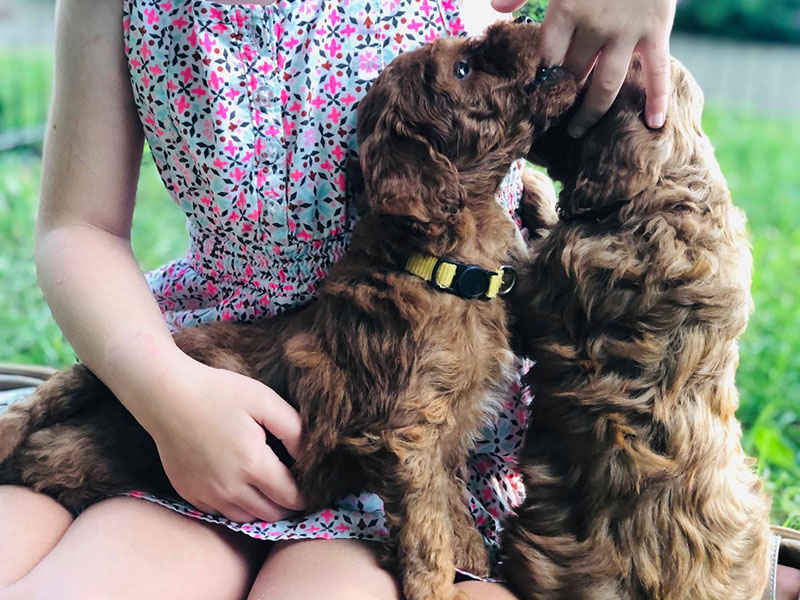
Why Do Puppies Bite Everything (Including You)?
Puppy biting is completely natural and necessary behavior—not a sign that you’ve somehow ended up with a defective puppy or that you’re failing as a dog parent. It’s frustrating for humans to manage, but we don’t label it as misbehavior when babies cry or need constant diaper changes. Puppy biting is the same—it’s a normal developmental phase, not a behavioral problem.
According to the American Kennel Club, mouthing and biting are completely normal behaviors for puppies, who use their mouths to explore their environment and learn about the world around them.
Just like human babies, puppies go through a teething process. Both babies and puppies are born toothless, but here’s the key difference: by the time your puppy comes home at 8 weeks old, they already have a full set of razor-sharp baby teeth. Human babies, on the other hand, gum around harmlessly for months before those tiny teeth begin to emerge.
But here’s the thing: puppies aren’t biting during play to relieve teething discomfort. Play biting serves a completely different and crucial purpose—it’s how they learn Acquired Bite Inhibition (ABI). This is one of the most important developmental behaviors your puppy will go through. Don’t waste this opportunity you’ve been given to create a safe adult dog.
Puppies bite when they’re:
- Learning how hard is too hard through play
- Excited and engaged
- Tired and overstimulated (yes, overtired puppies bite MORE)
- Exploring their world with their mouths
And here’s a fun observation: puppies seem to have a particular fondness for one specific type of toy—children. Kids’ high energy, quick movements, and delightfully squeaky voices make them irresistible playmates from a puppy’s perspective. If you have kids at home, you’ve probably noticed they bear the brunt of the shark-a-doodle phase.
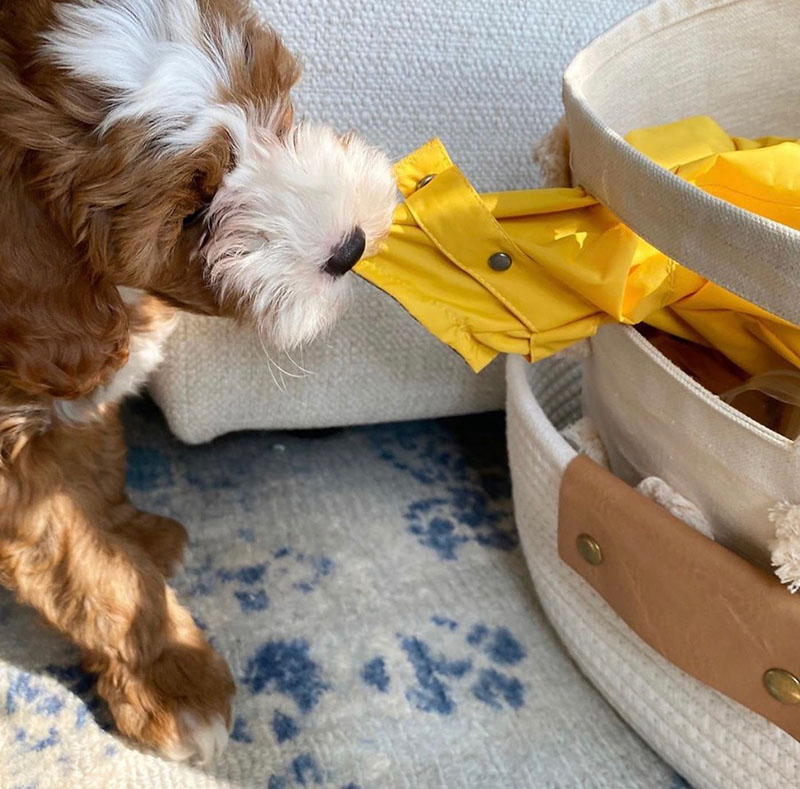
The Good News About Those Needle Teeth
Here’s something that will help you survive the next few weeks: even if your puppy is still in the biting stage after their baby teeth fall out (which happens around 3-6 months), it hurts SO much less. Those adult teeth aren’t nearly as sharp as the baby needles.
Why do puppies have such sharp teeth in the first place? It’s actually brilliant design by Mother Nature. Puppies need those needle-sharp teeth because they have relatively weak jaw muscles. The sharp teeth allow them to get a reaction and receive feedback on their bite pressure even with their weak puppy jaws. An adult dog that has never adequately developed bite inhibition won’t know how to monitor and adjust the force of their jaws when they have big adult teeth and big adult jaw muscles.
This is why bite inhibition is so critical—it’s literally a safety issue. According to the American Veterinary Society of Animal Behavior, early socialization and bite inhibition training during the critical developmental period are essential for preventing behavior problems later in life.
So the bottom line is you don’t want to stop puppy biting because then the bite training stops too.
Many families tell us that once the puppy teeth are gone, the biting becomes much more manageable even if the behavior hasn’t completely stopped yet.
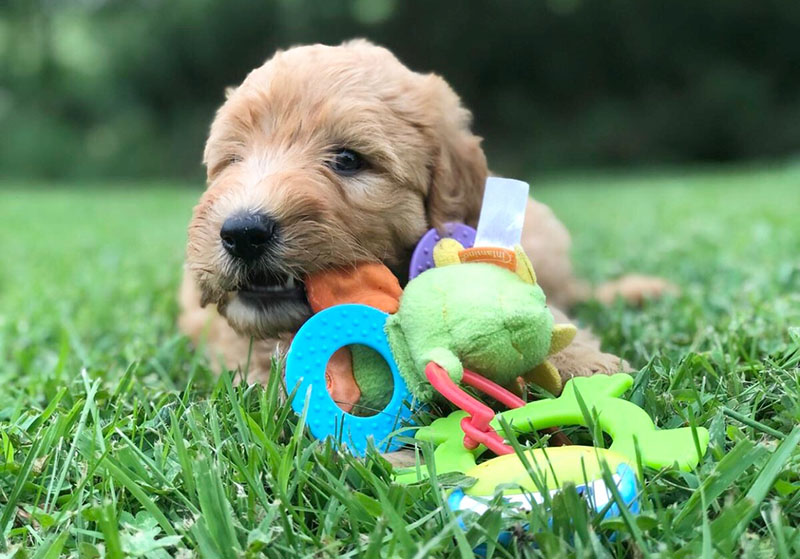
Understanding Bite Inhibition: Intensity Before Frequency
This is critical to understand: the correct progression is reduced intensity (softer bites) BEFORE reduced frequency (fewer bites).
Biting will get softer before you see them do it less. These are separate variables, and they must be addressed in this order. Force has a training time limit; frequency does not. If you’ve given consistent, timely, and appropriate feedback, you’ll notice your puppy’s biting getting softer and softer over the weeks. The play biting will eventually just be soft mouthing. At that point, it becomes appropriate to start addressing how often it happens.
One or two training sessions won’t do it. It takes weeks of consistent work to see real progress. Remember, you’re not trying to stop biting with this strategy—you want to see it getting progressively softer over time. And here’s the encouraging part: once you understand what you’re looking for, you’ll start noticing those subtle improvements. Each slightly gentler bite is a win worth celebrating.
The Critical Timeline
By about 18 weeks, the brain chemistry starts changing and your window for learning acquired bite inhibition will start closing. Don’t wait! By six months, it will be pretty much closed, and the strategies we’re talking about won’t work anymore.
If you have an eight or nine-month-old dog jumping up and grabbing your arms or sleeves, and you haven’t done this work already, you’re going to be in a tough spot. You’ll need different methods to address that because off-leash classes, crying out, or walking away won’t work anymore. Now you can really only focus on frequency, and the force of biting is what it is. Contact a qualified force-free trainer or veterinary behaviorist near you to help you out.
This is why adopting older puppies requires understanding what developmental stages they’ve already passed through.
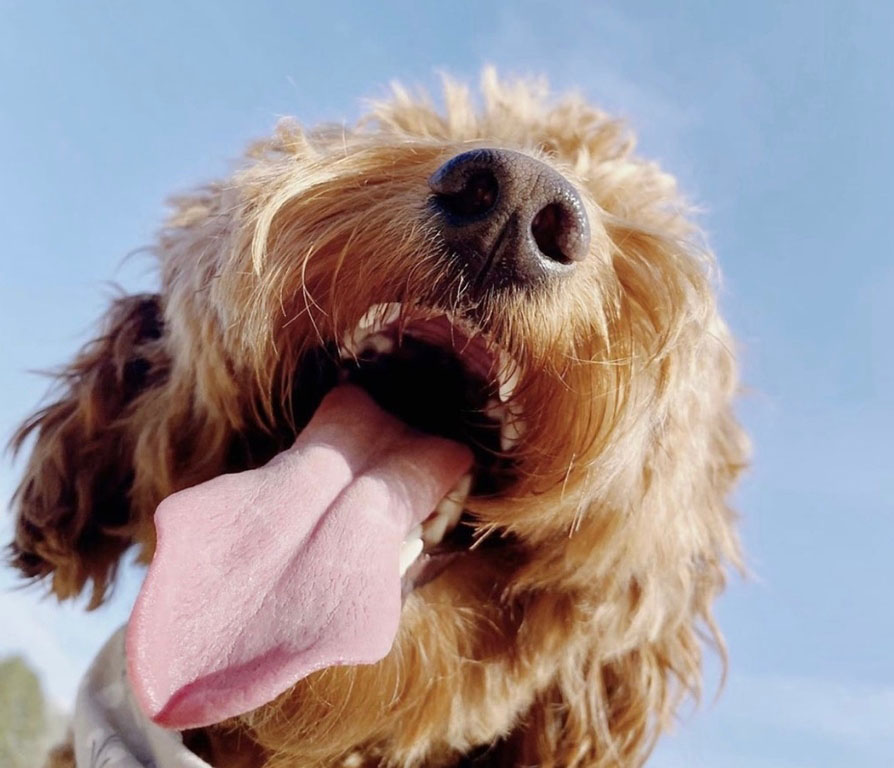
Bad Advice to Ignore: What NOT to Do
Before we get into what TO do, let’s clear up some common myths. There are a lot of outdated methods floating around the internet that don’t actually help with bite inhibition. Here’s what doesn’t work:
Common Puppy Biting Myths That Don’t Work:
- Tapping on the nose – This might get temporary relief because your puppy stops interacting with you, but it teaches them you’re unpredictable, not that biting hurts
- Squirt bottles – This method is lazy and irresponsible (we don’t squirt babies in the face when they do something that annoys us)
- Using muzzles – These prevent all mouth interaction, which means no eating, drinking, playing with toys, or anything else related to being a puppy. Plus, it pretty much guarantees you’ll end up with a hard biter as an adult
- Crate timeouts – Crates should never be used as punishment. Your puppy’s crate needs to remain a positive, safe space. Using it for timeouts creates negative associations that can lead to crate anxiety
- “Leave it” or “Drop it” commands – These are important skills to teach separately, but they’re useless for play biting because they don’t provide the right kind of feedback
All of these methods either provide no constructive feedback or actively interfere with your puppy’s ability to learn bite inhibition. We use strictly non-aversive training methods because they’re more effective and build trust with your puppy.
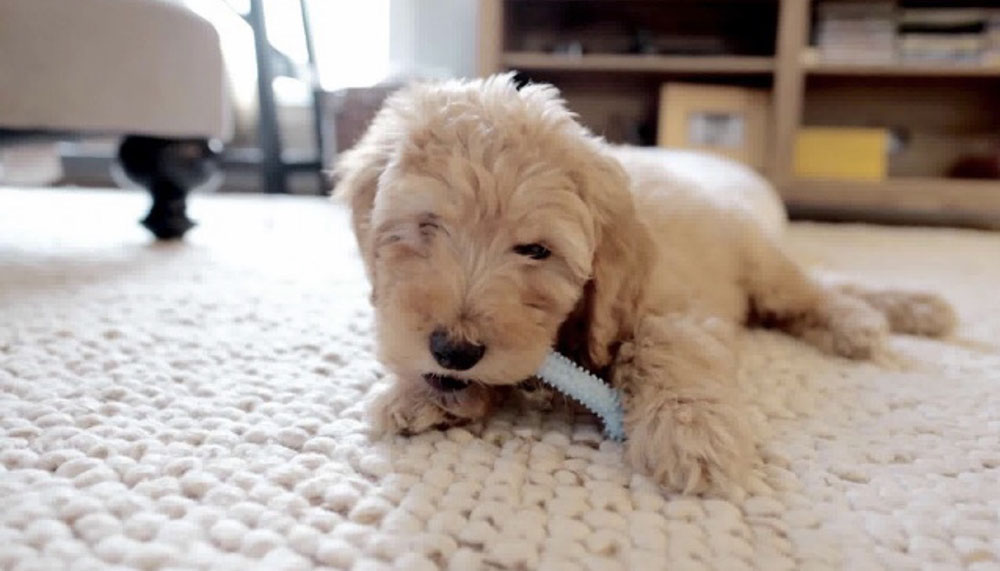
The Right Way: “The Secret” Technique
Here’s the method that actually works for teaching bite inhibition. It requires consistency, but it’s incredibly effective:
When your puppy bites during play:
1. Stay engaged – Don’t pull away quickly. Quick movement triggers their chase drive and makes them bite harder. Instead, leave your hand where it is—your puppy needs to be the one to back off.
2. Say “Ouch!” loud enough and sharp enough – When your puppy bites too hard, give immediate vocal feedback. Your puppy should buck their head back in response to the sound.
3. Immediately praise – The second they pull back, start praising enthusiastically: “Ouch! Good, good boy! Thank you!” The praise needs to be immediate and genuine.
4. Allow them to re-engage – If they’re softer, tell them “good puppy.” If not, repeat the feedback. Keep the tone upbeat and the volume appropriate—you want to give clear information without scaring them.
5. Cry out even for clothing or hair – Your puppy doesn’t know the difference between skin, clothing, and hair. They should eventually be gentle with all of it.
When your puppy is too jazzed up:
Sometimes your puppy will be too overstimulated to respond to the training. When this happens:
Leave simple as that – Don’t put the puppy in timeout; that’s not fast enough and isn’t instructive. YOU get up and leave. Come back in 30-60 seconds and try playing again. This mimics how puppies learn from each other—a hard bite produces a yelp and the other puppy stops playing momentarily.
You have to be able to get away when the puppy is too intense, which is why we use gates and controlled spaces early on.
Important reminders:
- Your commentary needs to be both consistent AND varied—right and wrong feedback delivered constantly over weeks
- Make sure to cry out even when they’re gentler but still learning. You’re teaching them the full range, from “way too hard” to “perfect”
- This is a progression that unfolds over weeks, not days
- This feedback needs to be both binary (right and wrong) AND constant. One or two times won’t do it
- Be patient with yourself and your puppy—learning takes time for both of you. Every interaction is a teaching opportunity.
Use Gated Spaces and Good Food Handling
Keep your puppy in controlled spaces (like gated rooms) during this phase. This serves two purposes: it gives them structure and routine while they’re learning, and it allows you to remove yourself when play gets too intense.
Also practice good food handling techniques to help prevent resource guarding and teach your puppy that hands near their food are a good thing, not a threat. Gentle tug for playful opposition and energy expenditure is also one of our favorite teaching tools. This provides an opportunity to build manners, impulse control, and more motivating reward structures.
Don’t Label It as “Bad Behavior”
Stop thinking of play biting as bad behavior. It’s not. Play biting is one of the most important developmental behaviors puppies go through. Do the only things puppies do more than bite is poop, pee, and sleep. That tells us that it’s important. There is a reason why Mother Nature has programmed them to do it so much.
Yes, it’s inconvenient for us humans, but it’s natural and necessary for your puppy’s development into a safe adult dog.
The Path Forward
As your puppy progresses through bite inhibition training, you should ideally have been integrating obedience training into your puppy work all along the way. Once the mouthing behavior becomes softer and more about controlling their environment than seeking feedback, you can use incompatible behaviors to redirect them.
By now the mouthing behavior is more about controlling their environment than it is trying to elicit feedback, so now you can focus on polite behaviors, redirecting, building impulse control, engaging them in interactive and instructive play, and simply continuing to give good representative feedback on their behavior.
And here’s an important note: chew toys are for quiet, calm chewing times—they help relieve teething discomfort. Chewing is relaxing and it does relieve teething discomfort, but play biting serves a whole other purpose. Don’t try redirecting to a chew toy during play biting. Play biting is about learning bite inhibition, and you’d be missing a crucial teachable moment.
Watch and Learn
For a detailed video walkthrough of this technique in action, check out our training video here: Puppy Biting? Learn Bite Inhibition Training!
The video demonstrates the proper timing, tone, and progression so you can see exactly how to implement these strategies with your shark-a-doodle.
You’re Going to Make It
Some days it won’t feel like it, but you’re doing better than you think. Every puppy goes through this. Every. Single. One. Those needle teeth will fall out. The constant mouthing will fade. And one day—probably sooner than you expect—you’ll look at your calm, gentle adult doodle and barely remember this phase.
The fact that you’re here, reading this, learning the right techniques? That’s what makes the difference. You’re setting your puppy up for success, and that matters more than you might realize right now.
Until then? Stay consistent with your feedback, keep your sense of humor intact, and remember: this is temporary, you’re not alone, and you’ve got this.
Deep breath in. Deep breath out. You’re doing great.
Frequently Asked Questions About Puppy Biting
Q: How long does the puppy biting phase last?
A: Every puppy is different, but you’ll typically see the most intense biting during the first few months home. As puppies lose their sharp baby teeth (usually around 3-6 months), the biting often becomes less painful even if the behavior continues. The key is focusing on bite inhibition training during that critical early window, which is most effective before 18 weeks of age.
Q: Why does my puppy bite me and not my partner?
A: Puppies often bite certain family members more because of how people react. Quick movements, high-pitched voices, or inconsistent responses can encourage more biting. Kids are especially targeted because their energy and movements trigger play drive. Everyone in the household needs to use the same training techniques consistently. Many Ohio families find it helpful to have a family meeting where everyone practices the technique together before implementing it with the puppy.
Q: Is puppy biting aggression?
A: No! Puppy biting during play is completely normal developmental behavior, not aggression. Puppies bite to learn bite inhibition—a critical life skill. Play biting and fighting is one of the most important developmental pieces puppies go through. It’s inconvenient for humans but absolutely necessary for creating a safe adult dog.
Q: Should I use bitter apple spray to stop puppy biting?
A: Bitter spray can deter chewing on objects, but it doesn’t teach bite inhibition and shouldn’t be used on skin. The goal isn’t to stop biting—it’s to teach your puppy to control bite pressure. Using deterrents interferes with this important learning process.
Q: My mini Goldendoodle puppy bites harder than other puppies. Is this normal?
A: Some puppies do have more intense play styles, and even mini Goldendoodles can seem forceful compared to smaller breeds. This is exactly why bite inhibition training is so important. The technique works for all puppies regardless of breed or intensity level—it just requires consistent practice over several weeks.
Q: Can I still teach bite inhibition to my 7-month-old puppy?
A: Unfortunately, the critical window for developing acquired bite inhibition closes around 18 weeks and is pretty much shut by 6 months. After that, you can work on reducing frequency of mouthing, but you can’t effectively teach a puppy to soften their bite. If you’re struggling with an older puppy, contact a qualified force-free trainer or veterinary behaviorist for personalized guidance.
Q: What’s the difference between play biting and teething?
A: Play biting is about learning bite inhibition and happens during interactive play. Teething is physical discomfort relief and happens with chew toys during calm, quiet times. Both are important, but they serve completely different purposes. Don’t redirect play biting to chew toys or you’ll miss the teachable moment for bite inhibition.
Q: Does the “yelp like a puppy” method work?
A: Only if you’ve specifically trained your puppy on what that sound means beforehand, and even then it stops bite training rather than teaching soft mouth. Without prior training, yelping is just meaningless noise to your puppy. The “Secret” technique described in this article is far more effective because it provides immediate, meaningful feedback.
Q: Are Cavapoos easier to train for bite inhibition than mini Goldendoodles?
A: All puppies need bite inhibition training regardless of breed. Smaller breeds like Cavapoos may seem less intense simply because they’re physically smaller, but they still need to learn proper mouth control. The training technique is the same for all doodle breeds.
Ready to Welcome a Well-Bred Doodle Puppy?
At Maple Hill Doodles, our puppies are raised right here in our Ohio home as part of our family. They receive early socialization and handling from day one to set them up for training success. We work with families throughout the puppy selection process to ensure the best match for your lifestyle.
Whether you’re interested in Goldendoodles, Cavapoos, or Cavadoodles, we’re here to support you through every stage of puppyhood—including those shark-a-doodle weeks!
Disclaimer: I am not a certified trainer or veterinary behaviorist. This article shares recommendations from professional experts in the field. For personalized guidance, please consult a qualified force-free trainer or veterinary behaviorist.

